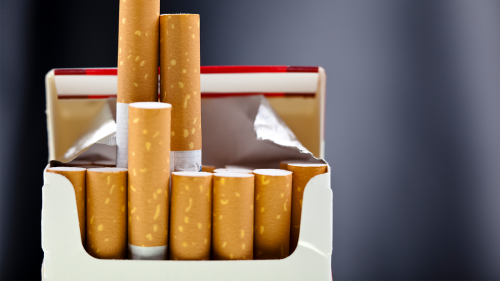Commercial Tobacco Use in American Indian and Alaska Native Populations

Download and Print: Fact Sheet Additional Languages
Many tribes use tobacco in a traditional way for ceremonial or medicinal purposes, such as healing ceremonies and offerings. Traditional tobacco use differs from commercial tobacco use. Commercial tobacco products are addictive and contain thousands of chemicals that harm the body due to regular use.
How common is commercial tobacco use in AI/AN populations?
Since 1978, American Indians/Alaska Natives (AI/AN) have had the highest use of commercial tobacco compared to people of other races or ethnicities.
Among AI/AN populations:
- 1 in 2 young adults aged 18 to 25 years use tobacco
- 1 in 5 adults aged 18 and over smoke cigarettes
- 1 in 12 adults aged 18 and over use smokeless tobacco
- 1 in 6 women smoked during pregnancy
Smoking prevalence is highest in the Northern Plains region (Iowa, Michigan, Minnesota, Montana, Nebraska, North and South Dakota, Wisconsin, and Wyoming)
What are the health risk of tobacco use?
The use of commercial tobacco affects nearly every organ in the body and can have serious health effects leading to disability and premature death. Smoking can lead to an increased risk of developing lung cancer, diabetes, heart disease, stroke, and chronic obstructive pulmonary disease (COPD).
Health risks also exist among AI/AN women using commercial tobacco products before, during, and after pregnancy. Some of these risks include fertility problems, premature birth, birth defects, and sudden infant death syndrome (SIDS).
Why should I quit?
Stay healthy by not using commercial tobacco products and be a positive role model for your loved ones, family, and community.
- 2 weeks after quitting, your breathing improves
- In 1 year, your risk for a heart attack is cut in half
- In 5 years, your risk for a stroke is the same as a person who never smoked
- In 10 years, your risk of lung cancer is reduced by half
- To lower your cholesterol levels
- To lower your risk of developing type 2 diabetes
- To lower your risk for gum disease
- To avoid exposing your friends and family to secondhand and thirdhand smoke
How do I quit?
FDA-approved smoking cessation products can help you quit. Talk to your doctor or pharmacist to find a treatment that is right for you.
- Over-the-counter nicotine replacement medications may come in the form of skin patches, gum, lozenges, inhaler, or nasal spray.
- Prescription products are available through a prescription from your health care provider. These products may come in the form of pills, inhaler, or nasal spray.
Where can I learn more?
The Indian Health Service has information on tobacco prevention at: www.ihs.gov/forpatients/healthtopics/TobaccoPrevention.
For resources to help you quit, visit: www.smokefree.gov.
To speak with a smoking cessation counselor, call the Centers for Disease Control and Prevention at: 1-800-Quit-Now (784-8669).
For more information on health equity, visit www.fda.gov/healthequity.
Download Fact Sheet
Additional Languages
We hope that you find these translations useful. While the agency has attempted to obtain translations that are as faithful as possible to the English version, we recognize that the translated versions may not be as precise, clear, or complete as the English version. The official versions of these materials are the English versions.
ᎾᏍᎩᏃ ᏗᎪᏪᎳᏅᎢ ᎡᎳᏗᏢ ᎨᏒ ᏗᏛᏅᎢᏍᏔᏅ ᎾᎿᎢ ᎢᎸᏍᎩ ᏙᏱᏗᏢ ᏂᏓᏳᎶᏒ ᏗᎦᏬᏂᎯᏍᏗ. FDA ᏓᎵᏍᎪᎸᏗ ᎯᎠᏃ ᏗᏁᏢᏔᏅᎯ ᎯᎢᎾᎢ ᎢᏯᏓᏛᏁᏗ ᎾᎢ ᎠᏯᏖᎾ ᎠᏰᎵ ᏍᏆᏂᏱ ᏚᎾᏙᏢᏒᎢ ᎤᎾᏛᏓᏍᏗ. ᎤᏚᎩ ᎣᎬᎭ ᎾᏍᎩᎾᎢ ᏣᏩᏛᏗ ᎯᎠᏃ ᏗᏁᏢᏔᏅᎯ ᏗᎨᎬᏙᏗ. ᎠᏏᏉ ᎾᏍᎩ ᏗᎦᏘᏯ ᎦᎵ ᎤᏁᎵᏔᏅ ᏧᏁᏍᏗ ᏗᏁᏢᏔᏅᎯ ᎾᏍᎩᎾᎢ ᎯᎾᎢ ᎤᏬᎯᏳᏒ ᎾᏍᎩ ᏱᎬᏩᎵᏍᏙᏗ ᎾᏍᎩ ᎩᎵᏏ ᏄᏓᎴᏒᎢ, ᎣᏦᎵᎩ ᎾᏍᎩᎾᎢ ᎠᏁᏢᏔᏅᎢ ᏂᏚᏓᎴᏒᎢ ᏰᎵᏊ ᏞᏍᏗ ᎾᏍᎩ ᎧᎵ ᏗᏙᎵᎩ, ᎤᎵᎦᎵᏴᏓ, ᎠᎴ ᎠᏍᏆᏛᏃᏅ ᎾᏍᎩ ᎩᎵᏏ ᏄᏓᎴᏒᎢ. ᎾᏍᎩ ᏗᏓᏂᎸᏨᎢ ᏄᏓᎴᏒᎢ ᎯᎠᏃ ᏗᎪᏪᎳᏅᎢ ᎾᏍᎩ ᎩᎵᏏ ᏄᏓᎴᏒᎢ.
Díí naaltsos wóyah gi sinilígíí di kwíí shį́į́h Bíla’ashdla’ii Ałtah Dóóne’é nilį́į go Bizaad ał ąą’á daa t’ée go bee’ áta’ ná háne’ go Ał tah Ádóóne’é kéyah t’áá’ náá hwís t’áa ńt’éé’ bá‘ ádeil yaa kojí FDA Da’ íníísh dóó. Kót’áó baa hane’ígíí bee’ áta’ ná háne’ go bó hó née dzą́ą́ go hane’ chii díłįł nii dzin t’áá’ daats’í nił ákó t’é. Kódóó Da’íníshígíí t’áá’ áyisíí Bilagáanaa bizaad bee ha’oo dzíí’ gi nízhóní go, k’éz don go, bik’izh doo txįł ígi’ át’áó nát’ą́ą’ bee’ ata’ ná hóóne’ doo nii dzin Ałtah Diné’é’ bizaad łah góó shį́į́ t’áá’ áaní t’áá nani tł‘ah ał tah Diné’é bizaad bee’ Bilagáanaa bizaad dę́ę́’ bee’ ata’ ná ho jil ne’ go ła’ saad bá’á daa din go da. Bilagáanaa bizaad jí’ áyisíí bó hól níh ílįį́ go bee ha’oo dzíí’jí dooléł hane’ yíníł ta’ go hazhó’ó bik’i’ di díí txįł.
Kalikat kanani igaumaut allat yuut ayuqenrilngurnek qaneryaraitgun. FDA-q kalikangqertuq mumigtanek allat nunarpiit qaneryaraitgun. Umyuartequukut mumigtat ikayurnakuyukluci. Pitacirramcetun mumigcillruukut ukunek kalikanek, taugaam pitsaqenritukut mumigtat ilait elluarrluteng igaumanricukluki. Kass’atun igaumalria elluatuqluni igaumauq.
